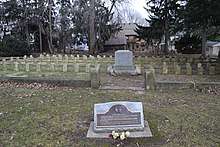Confederate Rest
Confederate Rest, in Forest Hill Cemetery, Madison, Wisconsin, is the northernmost Confederate graveyard in the nation.[1] In it lie 140 Confederate prisoners of war who died under Union captivity.

History
Origins
— Private Paddock, of the 19th Wisconsin Regiment[2]
Following the Battle of Island Number Ten, about 1400 Confederate soldiers who surrendered there, many from the 1st Regiment Alabama Infantry, were taken at the end of April, 1862, to the Union training field Camp Randall in Madison, Wisconsin, which was found to be unsuitable,[3] resulting in the deaths of 140 prisoners before the remaining survivors were sent to Camp Douglas (Chicago) at the end of May, 1862.[4]
Mass grave and reorganization
The dead prisoners were interred in a mass grave. In the early years, Alice Waterman, a Madison resident who lived near the cemetery, cared for the burial grounds using her own funds.[5] Later, each deceased was given his own tombstone.[6]
Confederate cenotaph removed
In January 2019, after a year-long debate, a stone cenotaph etched with the names of Confederate 140 prisoners of war was removed from the cemetery by the Madison Parks Department and transferred to storage at the Wisconsin Veterans Museum.[7]
References
- Editorial Board Wisconsin State Journal (29 August 2018). "Landmarks Commission right to keep Confederate marker in Madison". Wisconsin State Journal. Retrieved 8 October 2018.
Some of the individual headstones of the Southern soldiers who died here are so worn they are unreadable. So the 4-foot stone monument helps identify who is buried at the “Confederate Rest,” the northernmost Confederate graveyard in the nation.
- AARON HATHAWAY. "Confederate captives in Madison: Camp Randall's history as Civil War prisoner-of-war camp". The Badger Herald. Retrieved 9 October 2018.
A Private Paddock of the 19th Wisconsin Regiment wrote to his family regarding these deaths: “They die off like rotten sheep. There was 11 die off yesterday and today, and there ain’t a day but what there is from two to nine dies.”
- Aaron, HATHAWAY (11 January 2016). "Confederate captives in Madison: Camp Randall's history as Civil War prisoner-of-war camp". The Badger Herald. Retrieved 9 October 2018.
U.S. Army officials deemed camp conditions unsuitable
- Office of School Services. "Confederate Prisoners at Camp Randall as Seen in Newspaper Articles". Wisconsin Historical Society. Retrieved 9 October 2018.
the camp hospital appeared unable to handle the sick Confederate patients. Due to the results of the inspection, the prisoners were transferred to Camp Douglas, Chicago, on the last day of May
- Confederated Southern Memorial Association (1904). History of the Confederated Memorial Associations of the South. NEW ORLEANS: THE GRAHAM PRESS. p. 130. Retrieved 9 October 2018.
Mrs. Alice Waterman, of Madison, Wis., who had from her private means cared for the graves of a large number of Confederate soldiers buried near her home
- Abigail Becker (11 April 2018). "Madison City Council votes to remove Confederate marker rather than add an interpretive sign". The Capital Times. Retrieved 9 October 2018.
Most of the 140 prisoners who died at Camp Randall and are buried at Confederate Rest were likely sick when they arrived in Madison [...] The soldiers were buried in a mass grave at the cemetery and later given their own headstones in Confederate Rest
- Petrovic, Phoebe (11 January 2019). "Confederate Monument In Madison Cemetery Removed". Wisconsin Public Radio. Retrieved 28 May 2019.